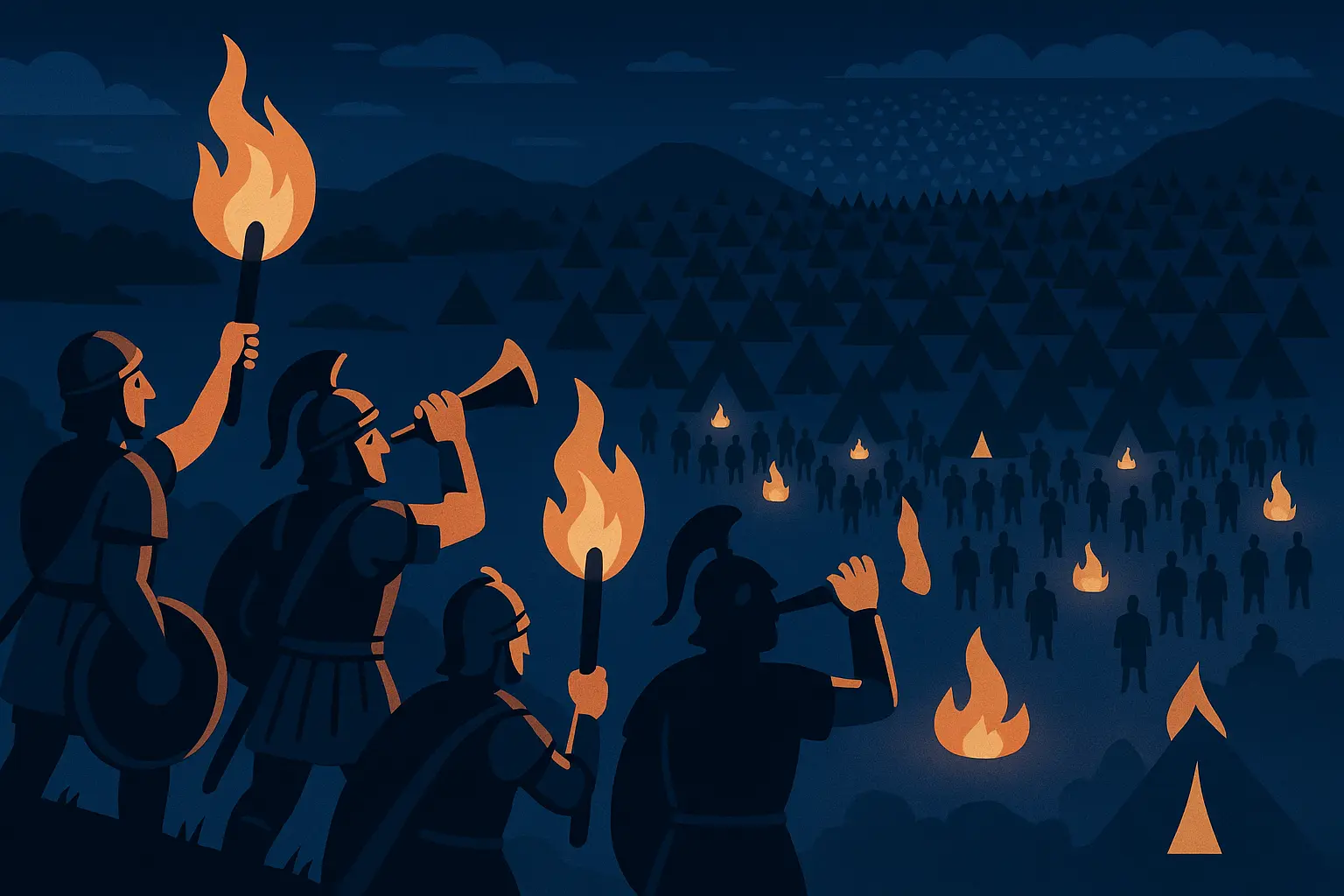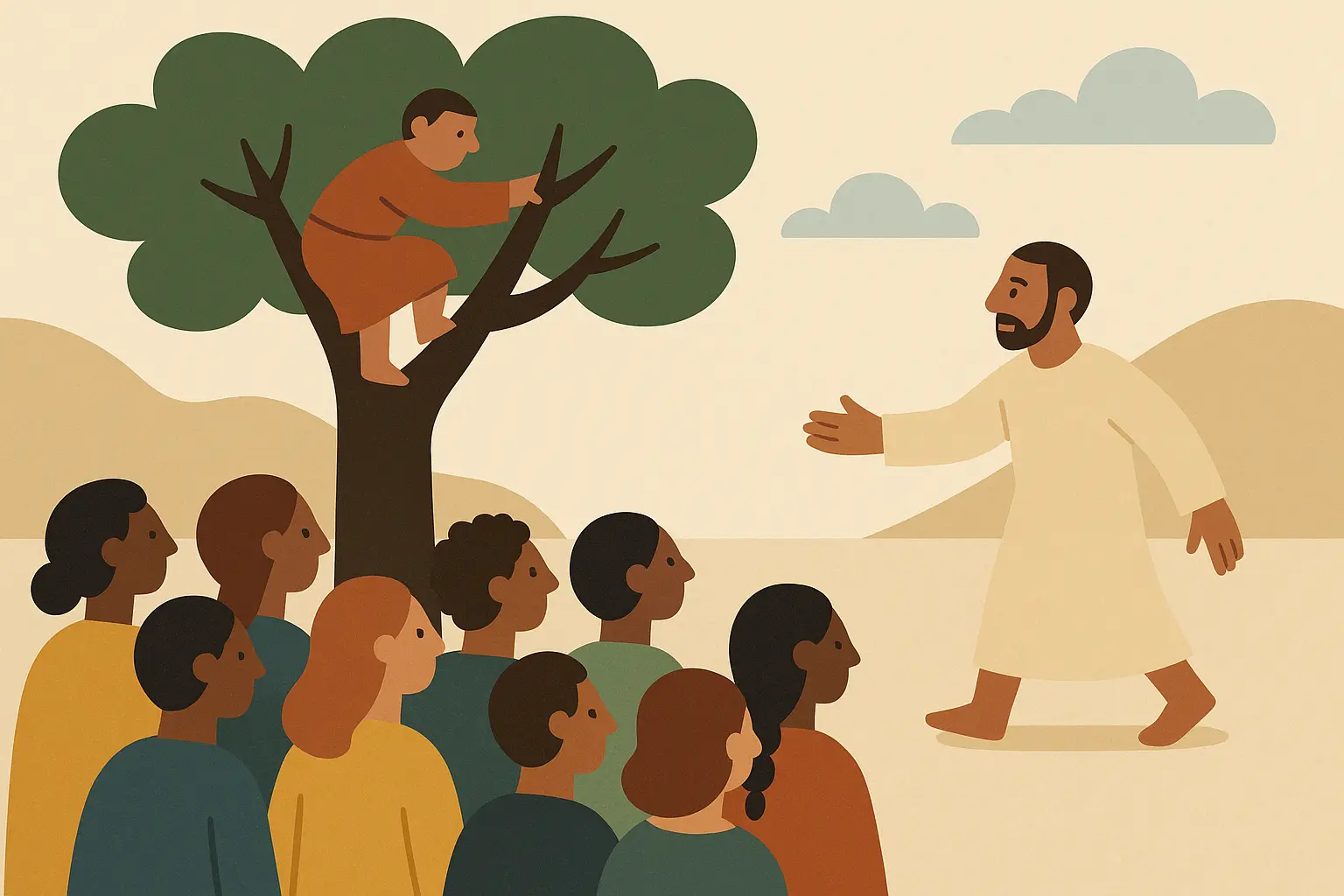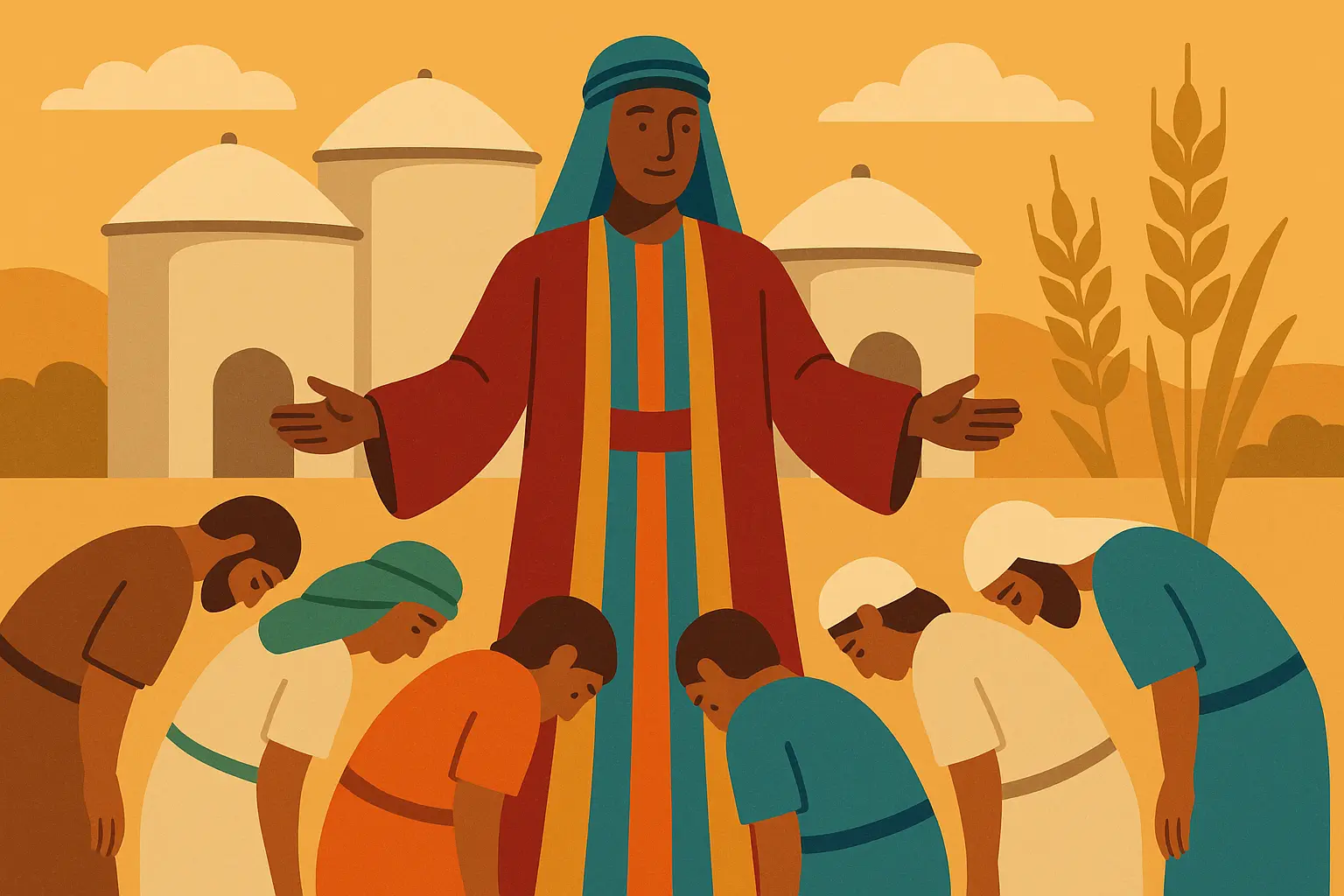Look, I get it. You crack open the Bible and it’s like staring at a massive library with over 31,102 verses across 66 books – where the heck do you even start? I remember feeling completely overwhelmed when I first tried to navigate this thing. It’s intimidating.
Here’s what’s crazy though – Barna Research found that over 181 million Americans opened a Bible in 2021, but most of us are in the same boat, struggling to figure out which stories actually matter for everyday life. That’s where this guide comes in. I’ve pulled together 25 biblical stories that have been helping people figure out life for thousands of years – stories about courage, forgiveness, wisdom, and second chances that still hit home today.
These aren’t just ancient tales collecting dust. They’re story themes that resonate across cultures and generations, offering lessons that feel surprisingly fresh when you’re dealing with modern problems.
What’s Coming Up
- What makes a Bible story worth remembering
- Leadership stories that’ll make you rethink courage
- Tales of redemption and second chances
- Stories about keeping faith when life gets brutal
- Wisdom stories for tough decisions
- Transformation stories that prove change is possible
- How these ancient stories apply to your actual life
- Tips for evaluating which stories pack the biggest punch
The Quick Version
Here’s the deal: These 25 stories fall into five main categories – leadership, redemption, faith through hard times, wisdom, and transformation. Whether it’s David taking on Goliath, the Prodigal Son coming home, or Job dealing with the worst year ever, these stories give you frameworks for understanding human nature and navigating life’s curveballs. They work whether you’re dealing with workplace drama, family issues, or just trying to figure out who you want to be. Plus, they’re proven templates if you’re into storytelling or creating content.
What Makes a Bible Story Worth Remembering
Here’s the thing – not all Bible stories are created equal. Some are just genealogy lists that’ll put you to sleep faster than counting sheep. But the ones that stick? They’ve got drama, relatable characters, and situations you can actually imagine yourself in.
The best biblical stories feel like they could happen today, just with different clothes and technology. They deal with universal human experiences – betrayal, forgiveness, facing your fears, making tough choices. These iconic bible stories have fundamental storytelling elements that have kept people talking for thousands of years.
| What to Look For | Stories That Hit Hard | Decent Stories | Meh Stories |
|---|---|---|---|
| Story Structure | Clear beginning, middle, end with real conflict | Some drama, keeps you interested | Confusing or flat |
| Characters | People you can relate to with real growth | Some development, moderately interesting | Cardboard characters |
| Modern Relevance | Feels like it could be about your life | Some applicable lessons | Needs a history degree to understand |
| Cultural Impact | Everyone knows the references | Pretty familiar | Never heard of it |
| Life Application | Gives you multiple ways to think about problems | Some practical insights | Interesting but not helpful |
Good stories have bones. They’re built on solid dramatic structure – you’ve got characters facing real problems, making tough choices, and dealing with consequences. These aren’t just “and then this happened” stories. They show you why it matters through characters you actually care about.
They feel relevant to your life. The best biblical stories tackle stuff you’re dealing with right now – difficult bosses, family drama, moral dilemmas, major life changes. They give you frameworks for thinking through experiences that are fundamentally human, whether you’re living in ancient Israel or modern America.
Everyone knows them. When someone says “David and Goliath,” you immediately get the underdog dynamic, regardless of your religious background. This shared cultural knowledge makes these stories powerful for communication – they’re shorthand for complex ideas that most people understand.
Leadership and Courage Stories
Let’s talk about the stories that deal with stepping up when everything’s on the line. These five tales show different flavors of leadership – from facing impossible odds to making decisions that affect everyone around you. What makes them powerful is that they’re about ordinary people who found extraordinary courage when it mattered most.

1. David and Goliath – When Size Doesn’t Matter
Picture this: You’ve got a teenage shepherd boy facing off against a nine-foot-tall professional warrior. It’s like bringing a slingshot to a tank fight. But here’s what’s brilliant about this story – David doesn’t try to fight Goliath on the giant’s terms.
Everyone wants to give David armor and a sword, but he’s like, “Nah, I’m good with what I know.” He uses his shepherd skills – the same ones that helped him take down lions and bears protecting his sheep. The lesson? Don’t try to be someone else when facing your giants. Use what you’ve already got.
I know a woman named Sarah who owned a small marketing firm. She was bidding against a massive agency for a city contract. Instead of trying to match their flashy presentation and corporate speak, she focused on what she did best – personal service, local knowledge, and the ability to pivot quickly. She knew the city council members personally, understood the community’s quirks, and could make decisions without running everything through a corporate hierarchy. Guess who got the contract?
David’s confidence came from his track record. Those lions and bears he’d fought? That was his resume. Your past victories, even the small ones, build the foundation for facing bigger challenges. The story reminds you to remember what you’ve already overcome.
2. Moses and the Exodus – Leading Through Uncertainty
Moses is basically dealing with the worst case of imposter syndrome in history. God shows up in a burning bush and says, “Hey, go tell Pharaoh to let my people go.” Moses’s response? “Um, I’m not good at public speaking. Maybe find someone else?”
But here’s what makes Moses’s story so relatable – leadership skills develop on the job. He starts out reluctant and uncertain, but through experience and necessity, he becomes the guy who leads an entire nation out of slavery.
The burning bush moment represents when your calling becomes clear. You might not get supernatural visions, but the story suggests that leadership opportunities often come when you’re just doing your regular job. Moses was tending sheep when his life’s mission showed up.
Here’s the part that really gets me – the ten plagues and Pharaoh’s stubbornness. Moses doesn’t give up after the first “no.” He keeps applying pressure, trying different approaches until breakthrough happens. This is your blueprint for organizational change, advocacy work, or any situation where you’re trying to move an immovable object.
3. Esther Saves Her People – Using Position for Purpose
Queen Esther’s story is like a political thriller. She’s won what’s basically a beauty contest to become queen, but then discovers her people are about to be wiped out. Her famous line – “If I perish, I perish” – shows what real courage looks like when personal safety conflicts with doing what’s right.
What I love about Esther is that she doesn’t just rush in. She’s strategic. She builds relationships, gathers information, and chooses the right moment to act. Sometimes courage looks like careful planning rather than dramatic gestures.
The beauty contest victory initially seems shallow, but the story reveals how unexpected paths can lead to positions of influence. Your current role, however you got there, might be preparation for something bigger. That job you think is just paying the bills? It might be positioning you for future opportunities to make a real impact.
Esther’s story teaches us that privilege comes with responsibility. If you’ve got influence – whether in your family, workplace, or community – you’ve got opportunities to protect people who can’t protect themselves.
4. Joshua and the Battle of Jericho – Following Unconventional Strategies
Joshua’s approach to conquering Jericho has to be one of the weirdest military strategies ever. March around the city walls for seven days, blow some trumpets, and watch the walls fall down? His generals probably thought he’d lost his mind.
But here’s the thing – sometimes the best strategies look crazy from the outside. Joshua had to maintain team morale and discipline for six days while nothing visible happened. That’s leadership: helping people maintain faith in the process when results aren’t immediately apparent.
The marching strategy required sustained commitment without immediate payoff. For six days, the walls were still standing. This teaches patience and persistence when you’re implementing long-term strategies that don’t show quick wins. How many good ideas get abandoned because people can’t handle the waiting period?
Joshua’s role was keeping everyone focused on a goal that looked impossible while dealing with daily skepticism. Sound familiar? That’s what leadership often looks like – helping others trust the process when outcomes aren’t guaranteed.
5. Gideon’s Victory – Overcoming Self-Doubt
Gideon’s story cracks me up. An angel shows up calling him a “mighty warrior” while he’s hiding in a winepress, scared of enemy raids. Talk about mixed messages. But that’s exactly why his story matters – leadership potential exists even when you don’t feel confident.
Gideon asks for multiple signs before accepting his mission. Some people see this as lack of faith, but I think it shows that uncertainty doesn’t disqualify you from leadership. You can doubt yourself and still take action.

Here’s the kicker – God reduces Gideon’s army from 32,000 to 300 men. The lesson? Sometimes having fewer committed people produces better results than managing a large, uncommitted group. Quality beats quantity when the mission is critical.
The army reduction process teaches important lessons about team selection. You want people who are alert, careful, and committed, not just warm bodies. Gideon’s victory shows that with the right strategy and the right team, you can accomplish way more than seems possible.
Redemption and Forgiveness Stories
Let’s talk about the really messy stuff – when we screw up, hurt people, and somehow find our way back. These stories don’t sugarcoat how hard forgiveness is, both giving it and receiving it. They show the complicated emotions involved when relationships get damaged and the long road back to trust.
6. The Prodigal Son – Coming Home After Failure
This story hits on three different levels because it’s really about three people dealing with forgiveness. You’ve got the kid who messed up big time, the parent who’s been waiting and watching, and the older brother who’s ticked off that the screw-up gets a party.
The younger son’s journey is every parent’s nightmare. He demands his inheritance early (basically saying “I wish you were dead”), blows it on parties and bad decisions, and ends up feeding pigs – which for a Jewish kid was rock bottom. But here’s what gets me – his decision to come home isn’t noble. He’s hungry and desperate.
The father’s response breaks all the rules. He runs to meet his son, which was considered undignified for a patriarch. He doesn’t wait for apologies or demand explanations. He just embraces the kid and throws a party. This challenges everything we think we know about proper consequences and earning forgiveness.
I knew a guy named Mark who struggled with gambling addiction. Lost the family savings, his wife’s trust, everything. After hitting rock bottom and entering recovery, he was terrified to go home. Expected anger, lectures, conditions. When he finally showed up at the door, his wife Lisa hugged him before he could even apologize. She’d been watching and waiting, choosing love over pride. But Mark’s brother-in-law? He was furious. “Why does he get forgiveness when I’ve been responsible all along?” – classic older brother syndrome.
The older brother’s anger reveals a different kind of spiritual poverty. His complaint about never getting a party exposes how resentment can grow even in people who seem to be doing everything right.
7. The Woman at the Well – Acceptance Beyond Social Barriers
Jesus’s conversation with the Samaritan woman breaks every social rule in the book. Jewish men don’t talk to Samaritan women. Religious leaders don’t associate with people who have messy personal lives. But here’s Jesus, having a theological discussion with someone who’s been married five times and is currently living with someone else.
The noon timing tells you everything. Women typically gathered water in the cool morning hours, chatting and socializing. This woman comes at noon – the hottest part of the day when no one else is around. She’s avoiding the judgment and whispers.
What I love about this story is how Jesus addresses both her intellectual questions and her personal shame. She tries to deflect with religious debate (“Should we worship here or there?”), but he sees through it to her real needs. Sometimes we hide behind theological arguments when what we really need is acceptance.
The woman becomes an evangelist to her whole town after this encounter. That’s what genuine acceptance does – it transforms shame into purpose. When someone sees past your worst mistakes to your actual worth, it changes everything.
8. Zacchaeus the Tax Collector – Transformation Through Encounter
Zacchaeus is basically the most hated guy in town. Tax collectors were seen as traitors and thieves, and he was the chief tax collector – the head traitor. But he’s also curious enough about Jesus to climb a tree for a better view, which had to look ridiculous for a wealthy, important man.
Jesus’s decision to invite himself to Zacchaeus’s house creates an uproar. The crowd grumbles about him eating with a “sinner.” But watch what happens – genuine transformation produces immediate, practical changes.

Zacchaeus doesn’t just say he’s sorry. He gives half his possessions to the poor and pays back everyone he cheated four times over. That’s not just words – that’s putting your money where your mouth is. Real change shows up in your bank account, your calendar, your relationships.
The story suggests that transformation often begins with curiosity. Zacchaeus wanted to see Jesus, even if it meant looking foolish. Sometimes the first step toward change is just being open to new possibilities.
9. Peter’s Denial and Restoration – Leadership After Failure
Peter’s story is every leader’s worst nightmare. This guy was Jesus’s right-hand man, the one who walked on water, who declared Jesus to be the Son of God. But when the pressure hit, he crumbled. Three times he denied even knowing Jesus, with increasing intensity – ending with cursing and swearing his denial.
The rooster’s crow is the moment of recognition. Sometimes it takes an external trigger to help us see our behavior clearly. Peter’s immediate weeping shows genuine remorse, which becomes the foundation for restoration.
But here’s what’s beautiful – Jesus doesn’t just forgive Peter, he restores him to leadership. The lakeside conversation mirrors the three denials with three opportunities to affirm love and commitment. This suggests that restoration often requires addressing failures as specifically as they occurred.
Peter’s failure and restoration teach us that past mistakes don’t disqualify you from future service. In fact, sometimes your failures prepare you to help others who are struggling with similar issues.
10. The Thief on the Cross – Last-Minute Redemption
Talk about cutting it close. This guy is literally dying when he has his moment of clarity. He recognizes Jesus’s innocence, admits his own guilt, and asks to be remembered in paradise. It’s the ultimate deathbed conversion.
What strikes me is the contrast between the two criminals crucified with Jesus. Same desperate situation, totally different responses. One continues in bitterness and mockery while the other recognizes his need for mercy. Circumstances don’t determine character – choices do.
The thief doesn’t ask to be rescued from physical death. He’s realistic about consequences while still hoping for spiritual acceptance . This realistic assessment combined with hope for mercy shows what genuine repentance looks like.
The story offers hope for anyone who feels they’ve waited too long to change. It’s never too late for transformation, even at life’s final moments. But it also shows that sincerity matters more than timing when it comes to redemption.
Faith Through Adversity Stories
These are the stories that deal with keeping faith when life absolutely sucks. They don’t promise that believing will make your problems disappear. Instead, they show how faith can provide meaning and strength when you’re going through hell.
These powerful narratives explore themes of perseverance and human resilience when everything seems to be falling apart.
| Character | What They Faced | How They Responded | What It Looks Like Today |
|---|---|---|---|
| Job | Lost family, health, money | Questioned but kept trusting | Chronic illness, grief counseling |
| Daniel | Political persecution | Kept praying despite danger | Workplace integrity, standing up to authority |
| Shadrach, Meshach, Abednego | Religious persecution | Stood together against pressure | Resisting peer pressure, group courage |
| Abraham | Asked to sacrifice his son | Obeyed despite confusion | Impossible family decisions |
| Noah | Long-term project with no proof | Kept building despite mockery | Long-term goals, environmental activism |
11. Job’s Testing – Maintaining Faith Through Loss
Job’s story is brutal. This guy loses everything – his kids, his wealth, his health – in what feels like a cosmic bet. His friends show up to “help” but basically spend the whole time telling him it’s his fault. If you’ve ever wondered why bad things happen to good people, Job’s your guy.
Job’s initial response – “The Lord gave and the Lord has taken away; may the name of the Lord be praised” – sounds almost superhuman. But don’t miss what comes later. Job gets angry, demands answers, and basically puts God on trial. The story shows that faith can include honest expression of rage and confusion.
The friends’ attempts to explain Job’s suffering are well-intentioned but terrible. They’re basically saying, “You must have done something wrong, because good people don’t suffer.” Sound familiar? We do this all the time – try to make sense of tragedy by finding someone to blame.
What I love about Job is that he doesn’t get neat answers. God shows up and basically says, “Were you there when I created the world?” It’s not an explanation – it’s a reminder that some things are beyond human understanding. But the relationship survives the questioning.
12. Daniel in the Lion’s Den – Integrity Under Pressure
Daniel’s got a problem. There’s a new law that says you can only pray to the king for thirty days. But Daniel has been praying three times a day toward Jerusalem his whole life. What do you do when following your convictions becomes illegal?
Daniel doesn’t make a big show of it or stage a protest. He just keeps doing what he’s always done – praying by his window at the regular times. Sometimes integrity looks like quiet consistency rather than dramatic gestures.
The king actually likes Daniel and doesn’t want to enforce the law, but he’s trapped by his own decree. This shows how political decisions can have unintended consequences that hurt innocent people. Darius spends the night worrying about Daniel instead of celebrating his power.
Daniel’s story teaches that maintaining your principles might lead to dangerous consequences, but consistency in character often produces long-term vindication. The lions don’t touch him, and he ends up more influential than before.
13. Shadrach, Meshach, and Abednego – Choosing Principles Over Safety
Picture this scene: There’s a 90-foot golden statue, an orchestra playing, and thousands of people bowing down on cue. Three guys remain standing. Talk about making yourself a target.
What I love about their response to Nebuchadnezzar’s threat is the “but even if He doesn’t” part. They’re basically saying, “God can save us, but even if He chooses not to, we’re not bowing.” That’s mature faith – trusting divine character without demanding specific outcomes.
The fiery furnace is heated seven times hotter than usual, which kills the guards who throw them in. But when the king looks into the furnace, he sees four figures walking around unharmed. Sometimes standing for your principles brings unexpected protection and support.
Their story provides a framework for resisting peer pressure and authority demands that conflict with your core values. Whether it’s workplace ethics or social conformity, sometimes you have to be willing to stand alone.
14. Abraham’s Sacrifice of Isaac – Ultimate Faith Testing
This story is disturbing on multiple levels. God asks Abraham to sacrifice the son He promised, the child Abraham waited decades to have. It challenges everything we think we know about divine character and parental love.
The three-day journey to Mount Moriah is psychological torture. Isaac’s innocent question – “Where’s the lamb for the sacrifice?” – creates unbearable tension. Abraham’s response – “God will provide” – shows faith speaking into complete uncertainty.

The last-minute provision of a ram caught in the bushes demonstrates divine timing and care, but only after Abraham proves his willingness to follow through. The story suggests that sometimes the test is more important than the outcome.
Abraham names the place “The Lord Will Provide,” suggesting the experience taught him something new about divine faithfulness. Sometimes our greatest tests become our strongest testimonies.
15. Noah and the Flood – Long-Term Commitment Without Immediate Evidence
Noah’s story is about persistence in the face of ridicule. God tells him to build a massive boat, but there’s no sign of rain. For years, he’s hammering away while his neighbors probably think he’s lost his mind.
The ark construction required enormous resources and planning without any visible evidence that the project was necessary. Noah had to maintain focus on a long-term goal while dealing with daily skepticism. This teaches persistence in pursuing important objectives even when others question your judgment.
The gathering of animals and the seven-day wait inside the completed ark before rain began shows that even after preparation is complete, timing often remains beyond our control. Sometimes you do everything right and then have to wait for circumstances to align.
When the rain finally starts, it validates Noah’s years of faithful work. But by then, it’s too late for anyone else to prepare. The story warns about the importance of acting on conviction before crisis hits.
Wisdom and Moral Choices Stories
These stories dig into the messy world of ethical decision-making. They show that wisdom often requires creative solutions rather than just following rules, and that moral choices frequently involve competing values where there’s no obviously “right” answer.
16. Solomon’s Judgment – Creative Problem-Solving
Solomon’s baby case is like the ultimate courtroom drama. Two women, one dead baby, one living baby, and identical stories with no witnesses. How do you figure out who’s telling the truth?
Solomon’s solution – threatening to cut the baby in half – is brilliant psychology. He creates a test that reveals character rather than relying on evidence. The real mother immediately offers to give up her child rather than see him harmed, while the false claimant agrees to the division.
This teaches that effective leadership often requires unconventional approaches that address underlying motivations rather than surface claims. Sometimes you have to create conditions that allow truth to reveal itself naturally.
The story shows that genuine love often involves personal sacrifice. The real mother was willing to lose her child to save his life. This principle applies beyond parenting to any situation where you truly care about someone’s welfare.
17. The Good Samaritan – Compassion Across Boundaries
Jesus tells this story to mess with people’s expectations. The hero isn’t the priest or the religious leader – it’s the Samaritan, someone Jews considered an enemy. The story redefines who counts as your “neighbor” based on actions rather than ethnicity or religion.
The priest and Levite’s decision to pass by might have been motivated by religious purity laws or personal safety concerns, but their inaction contrasts sharply with the Samaritan’s immediate response. Sometimes religious knowledge without compassionate action misses the point entirely.
Dr. Jennifer Martinez, an ER physician, treated a homeless assault victim despite her packed schedule and his inability to pay. She arranged social services, personally drove him to a shelter, and followed up on his care. Her colleagues cited liability concerns and hospital policies as reasons for minimal treatment. Dr. Martinez’s compassion transcended professional boundaries, showing that true neighborliness requires personal investment.
The Samaritan’s comprehensive care – bandaging wounds, providing transportation, paying for lodging, and promising additional support – shows that effective help often requires sustained commitment rather than one-time assistance.
18. Cain and Abel – The Consequences of Jealousy
The first murder in human history stems from sibling rivalry and jealousy over divine approval. Cain’s sacrifice isn’t accepted while Abel’s is, and instead of examining his own heart, Cain gets angry and takes it out on his brother.
God’s warning to Cain – that sin is “crouching at the door” – applies to everyone facing moral choices. We all have moments when we can choose between dealing with our emotions constructively or letting them drive us to destructive behavior.
Cain’s response to God’s question “Where is your brother?” – “Am I my brother’s keeper?” – reveals his attempt to avoid responsibility. This demonstrates how moral failure often involves denying accountability for our actions and their effects on others.
The mark God places on Cain to protect him from revenge shows that even serious moral failure doesn’t eliminate divine concern for human welfare. Justice and mercy can coexist in addressing wrongdoing.
19. Joseph and His Brothers – Forgiveness and Providence
Joseph’s story is like a soap opera spanning decades. Favorite son with the fancy coat gets sold into slavery by jealous brothers, rises to power in Egypt, then gets the chance for revenge when his family needs help during a famine.
Joseph’s colorful coat and his dreams about his family bowing to him create the initial jealousy. The story suggests that favoritism and insensitive communication can contribute to family conflicts, even when the favored person isn’t trying to cause problems.

His refusal of Potiphar’s wife’s advances shows moral integrity under pressure, but his subsequent false imprisonment demonstrates that doing right doesn’t guarantee immediate reward. Ethical behavior has intrinsic value regardless of short-term consequences.
Joseph’s revelation to his brothers and his explanation that “you intended to harm me, but God intended it for good” shows a mature perspective on suffering that finds meaning without excusing wrongdoing.
20. The Rich Young Ruler – Choosing Between Competing Values
This wealthy young man’s encounter with Jesus reveals how hard it can be to choose spiritual values over material security. He claims to have kept all the commandments since youth, showing serious religious dedication, but he can’t bring himself to sell his possessions and follow Jesus.
The young man’s question about eternal life suggests genuine spiritual seeking, and his moral track record indicates real commitment. But Jesus’s specific challenge reveals that intellectual and behavioral compliance might not address deeper heart issues.
His departure “sad, because he had great wealth” shows the emotional difficulty of choosing between competing values. The story doesn’t condemn wealth itself but illustrates how attachment to material security can prevent spiritual growth.
Jesus’s comment that it’s easier for a camel to go through the eye of a needle than for a rich person to enter heaven isn’t about economics – it’s about the difficulty of depending on God when you’re used to depending on your resources.
Transformation and New Beginnings Stories
These are the stories about dramatic life changes and fresh starts. They show that transformation is possible regardless of your past while illustrating the various catalysts that can trigger major life changes.
21. Paul’s Conversion – From Enemy to Advocate
Paul’s transformation from Christianity’s chief persecutor to its greatest missionary is one of history’s most dramatic career pivots. Imagine going from prosecuting people to defending the very cause you used to oppose.
Paul’s zealous persecution of Christians before his conversion shows how sincere conviction can be misdirected. He genuinely believed he was serving God by opposing Christianity. This teaches humility about our own certainty and openness to new information.
The three-day blindness following his Damascus road vision creates a period of dependence and reflection. Sometimes transformation requires stepping away from normal activity to process new understanding and direction.
Ananias’s role in Paul’s restoration shows how community support facilitates personal transformation. Despite his fear of Paul’s reputation, Ananias helps his former enemy, demonstrating how acceptance can support change processes.
22. The Resurrection of Jesus – Victory Over Death
The resurrection represents the ultimate transformation story – victory over humanity’s greatest enemy, death itself. The disciples’ initial disbelief followed by joy shows how unexpected good news can be difficult to accept even when desperately hoped for.
The women’s early morning visit to the tomb shows faithful devotion even in grief, but their discovery creates confusion rather than immediate joy. Sometimes dramatic positive changes feel disorienting rather than celebratory.

The disciples’ varied responses – Peter and John running to investigate, Thomas demanding proof, the Emmaus travelers not initially recognizing Jesus – show different ways people process extraordinary claims. The story validates skepticism while encouraging openness to evidence.
23. Nicodemus and Being Born Again – Spiritual Rebirth
Nicodemus’s nighttime conversation with Jesus explores spiritual transformation through the metaphor of being “born again.” His position as a Pharisee contrasts with his genuine spiritual seeking, showing that religious knowledge doesn’t guarantee spiritual understanding.
Nicodemus’s nighttime visit might indicate secrecy due to his position or genuine desire for uninterrupted conversation. His respectful opening shows he’s taking Jesus seriously while his questions reveal confusion about spiritual concepts.
The “born again” metaphor confuses Nicodemus, who interprets it literally rather than spiritually. This demonstrates how transformation often requires new ways of thinking that transcend familiar categories.
24. The Creation Story – Order from Chaos
The Genesis creation account presents the ultimate transformation narrative – divine action bringing order, beauty, and life from formless void. The progressive development from light to land to life demonstrates purposeful design.
The repeated phrase “and God saw that it was good” suggests that transformation should result in something valuable and beautiful. This provides a standard for evaluating whether changes in our lives are moving in positive directions.
The creation of humans “in God’s image” establishes inherent dignity regardless of circumstances or achievements. This foundational concept supports human rights and the potential for meaningful contribution.
25. Pentecost – Birth of a Movement
The Pentecost event transforms fearful disciples into bold witnesses through the arrival of the Holy Spirit. The supernatural phenomena – wind, fire, and speaking in various languages – create a public spectacle that draws crowds.
The disciples’ gathering shows unity and expectation, but the dramatic arrival exceeds their anticipations. The wind and fire imagery suggests power and purification, while the multilingual ability addresses practical communication needs.

Peter’s bold sermon contrasts sharply with his earlier denial of Jesus, demonstrating how empowerment can transform personality and behavior. His explanation results in 3,000 new believers, showing how personal transformation can influence others.
How These Ancient Stories Apply to Your Actual Life
Here’s where these stories get practical. They’re not just ancient literature – they’re frameworks for dealing with stuff you’re facing right now. Whether it’s workplace drama, family issues, or personal growth, these narratives offer tested approaches to universal human challenges.
Work and Career Stuff
David and Goliath principles apply directly when you’re the small company competing against industry giants. Focus on your unique strengths rather than trying to match their resources. Esther’s strategic approach works for workplace advocacy and organizational change.
Solomon’s baby judgment offers frameworks for conflict resolution and creative problem-solving in management. His ability to reveal truth through insight rather than formal procedures applies to team dynamics and personnel decisions.
Family and Relationship Drama
The Prodigal Son story works for family counseling, especially with addiction, rebellion, or estrangement. It addresses multiple perspectives – the wayward family member, the patient parent, and the resentful sibling.
Joseph’s forgiveness of his brothers creates a model for processing betrayal and rebuilding trust in damaged relationships. His ability to find meaning in suffering without excusing wrongdoing provides balance between accountability and reconciliation.
Personal Growth and Mental Health
Job’s experience offers frameworks for processing grief, chronic illness, and existential questioning. His honest expression of anger and confusion while maintaining underlying faith shows that spiritual health can coexist with emotional struggle.
Paul’s dramatic conversion provides hope for those seeking major life changes, whether in career, relationships, or personal habits. His transformation shows that past behavior doesn’t determine future potential.
| Life Situation | Biblical Story | How It Helps | Practical Application |
|---|---|---|---|
| Addiction Recovery | Prodigal Son | 12-step programs, family therapy | Accountability groups, restoration process |
| Leadership Development | Moses, David, Esther | Executive coaching, change management | Mentoring programs, strategic planning |
| Conflict Resolution | Solomon’s Judgment | Mediation, workplace disputes | Creative problem-solving, truth-revealing techniques |
| Grief Counseling | Job’s Testing | Therapy, support groups | Honest expression, community support |
| Career Transitions | Paul’s Conversion | Professional pivoting, skill development | Network building, identity reformation |
Evaluating Stories for Maximum Impact
Not all stories hit the same way. Some will resonate with your current situation while others might feel irrelevant. Here’s how to figure out which ones are worth your time and attention.
Does It Make You Feel Something?
The best stories create emotional connections that help you internalize lessons. Job’s suffering, David’s courage, and the Prodigal Son’s homecoming engage both your head and your heart. Stories that only inform without moving you tend to have less lasting impact.
Can You See Yourself in It?
The most valuable stories address challenges you recognize. The Good Samaritan’s message about helping across cultural boundaries speaks to modern discussions about prejudice. Daniel’s integrity under workplace pressure applies to contemporary professional ethics dilemmas.
Does It Help You Think Differently?
Effective stories offer multiple ways to look at situations. The Prodigal Son works for discussions about parenting, addiction recovery, sibling rivalry, and forgiveness. This versatility makes certain stories more valuable for different life situations.

Can You Actually Use It?
Stories that provide clear behavioral models or decision-making frameworks offer more practical value than those that just illustrate abstract principles. David’s approach to Goliath gives you a template for facing overwhelming challenges. Solomon’s judgment shows creative problem-solving in action.
Using Bible Stories in Contemporary Storytelling
These ancient narratives provide proven story structures that work because they’re based on fundamental human psychology rather than cultural specifics. Whether you’re creating content, giving presentations, or just trying to make a point, these stories are like cheat codes – people already know them, so you can build on that familiarity.
Writers looking to understand how these timeless narratives work can benefit from exploring the science behind effective storytelling and how biblical structures tap into fundamental human psychology.
Character Templates That Work
Biblical figures provide rich character templates for modern storytelling. The reluctant leader (Moses), the transformed enemy (Paul), the wise judge (Solomon), and the courageous advocate (Esther) represent universal personality types that appear across cultures.
A modern Moses might be a reluctant CEO taking over a failing company, while a contemporary Esther could be a young politician using her position to protect vulnerable populations. These archetypes work because they’re based on real human psychology.
Plot Structures People Understand
The underdog triumph (David and Goliath), the redemption arc (Prodigal Son), and the transformation story (Paul’s conversion) provide frameworks that audiences instinctively understand. These structures work across genres – a David and Goliath story could be set in a corporate boardroom, sports arena, or courtroom.
Modern storytellers can also explore how folktales and biblical narratives share similar structures and archetypal patterns that resonate across cultures.
Themes That Never Get Old
Biblical stories address universal themes including justice, forgiveness, courage, and wisdom that remain relevant across cultures and time periods. Modern writers can explore these themes through contemporary scenarios while drawing on the psychological insights these ancient narratives provide.
Nairrate’s AI story generator understands these narrative patterns and can help writers adapt biblical story structures for modern audiences. Whether you’re creating content for entertainment, education, or inspiration, the platform’s ability to recognize character archetypes and plot progressions makes it invaluable for developing compelling narratives.

The AI’s capacity to generate character backgrounds, plot developments, and thematic elements helps bridge the gap between ancient wisdom and modern storytelling techniques. You can input basic biblical story elements and receive contemporary adaptations that maintain the original’s emotional impact while updating cultural references for today’s audiences.
Whether you’re crafting powerful anecdotes for presentations or developing full narratives, understanding these biblical foundations can strengthen your storytelling impact.
Final Thoughts
These 25 biblical stories aren’t just ancient literature collecting dust on a shelf – they’re frameworks for understanding human nature, making tough decisions, and navigating personal transformation. Their continued relevance across cultures and centuries shows their insight into universal human experiences that transcend historical context.
Whether you approach these narratives from a religious perspective or simply as powerful literature, their psychological depth and practical wisdom offer valuable guidance for contemporary challenges. From leadership development to relationship repair to personal growth, these stories provide tested models for life’s complexities.
The key to unlocking their value is moving beyond surface-level familiarity to deeper engagement with their characters, conflicts, and resolutions. Each story rewards careful study with fresh insights and practical applications that can inform your decisions and relationships.
So here’s what I’d suggest: Pick one of these stories that hits you where you live right now. Don’t worry about the theology or historical context – just sit with the human drama for a while. Maybe start a conversation with someone about which of these stories resonates with them. You might be surprised what you learn.
As you encounter these narratives – whether through personal reading, teaching others, or adapting them for modern storytelling – remember that their power lies not just in their historical significance but in their continued ability to illuminate the human condition and point toward hope, wisdom, and transformation.
For those interested in creating their own compelling narratives inspired by these timeless stories, exploring techniques for crafting impactful short fiction can help you distill these powerful themes into your own creative work.



Add comment